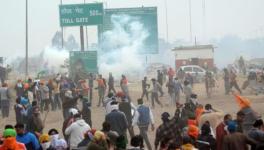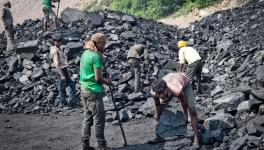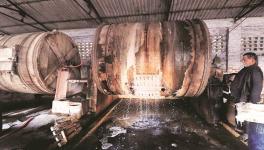Large-scale Illegal Mining in Himachal Creates Deep Ravines in Rivulets
Image for representational use only; Image Courtesy : Himachal Watcher
Large-scale illegal mining seems to have created deep ravines in Chaki river in Himachal Pradesh and in Punjab. A look from the bridge connecting Pathankot district of Punjab with Kangra District of Himachal Pradesh reveals deep ravines ranging up to 100 feet downwards from the edge of the railway bridge. The riverbed level has dipped steeply beyond the railway bridge. In fact, the bridge of narrow-gauge railway line that connects Pathankot with Kangra has become risky due to the ravine created in the riverbed. The railway authorities have constructed a concrete platform under the pillars of the bridge to save it.
The narrow-gauge railway line from Pathankot stretches up to Joginder Nagar in Mandi District of Himachal, and was built by the British in 1926. It is the lifeline to many areas of Kangra District.
Earlier, two pillars of the bridge were endangered due to illegal mining, and the old road bridge over the river had collapsed, and a new one had to be constructed. Sources believe that even though the Railways has created a concrete platform under the threatened pillars of the bridge over Chaki river, it is unlikely to last long, as the river has gotten converted into a ravine just below the bridge. Due to large scale illegal mining downstream, the river bed in the upper region has got eroded, leading to formation of ravines.
While launching ‘Hisab Maange Himachal’ in September 2017 before the assembly elections, BJP’s national spokesperson Sambit Patra had said that in the last four years, over 30,000 cases of illegal mining were detected in the state due to which losses worth Rs 2400 cr were borne by the state.
So once the present ruling party, the BJP came to power, to curb the illegal mining, the state Industries Department launched a drive with the help of police, so that on receiving information about illegal mining, immediate action could be initiated. State Industries Minister Bikram Singh had said that the state government would go to any length to stop illegal mining, and that mining rules would be made stricter.
The state government then amended the Himachal Pradesh Minor Minerals (Concession) and Minerals (Prevention of Illegal Mining Transportation and Storage) Rules-2015 with an objective to simplify procedural requirements, and to punish offenders.
While there was no enhancement in imprisonment for illegal mining, which is two years at present, the fine was increased by 20 times – from Rs 25,000 to Rs 5 lakh.
The penalty for illegal extraction of minerals was increased from Rs 400 to Rs 500. The fine for mechanical mining at riverbeds and illegal storage was doubled from Rs 25,000 to Rs 50,000. The department auctioned 57 sites on the government land, fetching a revenue Rs 11.70 crore, while survey documents of all 12 districts have been received, and more sites were to be auctioned soon according to Principal Secretary (Industries) RD Dhiman.
He said that to ensure transparency, all procedures had been made available online, with the launch of the mining portal of the geological wing of the Industries Department by Chief Minister Jai Ram Thakur. Applicants would be able to apply online for various services of the geological wing like approval certificate, mining lease, stone crusher, issue of transit pass and M-form generation, which will ensure transparency and reduce human interface.
The whitewashing attempt of the Jairam Thakur government could clearly not succeed, and the National Green Tribunal (NGT) on November 1, 2018, quashed the permission granted to stone-crushers within 100 metres of the rivers and water bodies in Himachal, declaring it illegal, and in violation of the Environment (Protection) Act, 1986. The NGT order could lead to the closure of a number of stone-crushers. The Industry Department has given permission to 347 crushers of which 121 are lying closed for various reasons and violation of the norms.
“The location of a stone-crusher close to a water body is against the principle of sustainable development as well as precautionary principle,” the court observed.
The issue of damage being caused by stone-crushers came under scrutiny of the NGT, as a complaint had been filed before it regarding one such stone-crusher at Sajaopiplu village in Sarkaghat of Mandi. “It has been noticed that stone-crushers are operating without the consent and illegal mining was also taking place,” the court observed.
The fact that illegal mining is taking place in Chaki river is illustrated through the money collected by the district Police as challans which sums up to the tune of Rs 2 crore. Over 1,000 cases of illegal mining have been registered, but it is hardly a deterrent for illegal mining in the Chaki river due to the amount of the money being generated in the exercise, and the deep-rooted interest of those in power in illegal mining operations.
The issue of illegal mining in border areas of Kangra came up for discussion in Himachal Pradesh State Assembly’s monsoon session way back in 2015 when the Nurpur MLA at the time, Ajay Mahajan, raised issue of unclear demarcation of interstate boundaries, leading to people from Punjab carrying out illegal mining in Chaki rivulet.
Admitting to the fact, the then Revenue Minister Kaul Singh Thakur had informed the house that Himachal would seek demarcation of its boundary satellite imagery to put an end to the illegal mining.
In September 2015, the field staff of the revenue departments from Pathankot and Nurpur had conducted a joint demarcation exercise, but left it incomplete.
Chakki rivulet, a tributary of Beas marks the boundary between Himachal and Punjab, but in absence of demarcation, the police and authorities find it difficult to take action against people from Punjab who carry out mining.
During 2015-16 financial year, 9,303 cases of illegal mining were detected, and a compounding fee to the tune of Rs 4.01 crore was imposed on them. Similarly, during financial year 2016-2017, 8,500 cases of illegal mining were detected and a compounding fee of Rs 4.50 crore imposed on them.
What is interesting is the fact that even after various attempts to “curb” illegal mining by the two governments, farmers in the border areas of Kangra district in Himachal Pradesh are up in arms over illegal mining. They have blamed police for inaction against those involved in such activities. Hoshiyar Singh, district president of Bhartiya Kisan Sangh, told Newsclick, “Due to illegal mining, there is scarcity of water, and roads to villages are destroyed by the movement of heavy vehicles. We have sent live videos to the police repeatedly, but there has been no action.”
He further said, “These illegal mining activities have taken a toll on our lives. We feel the state government has abandoned the farmers of border area villages. The use of heavy earth moving machinery has changed the course of water, and we are forced to sell our produce in markets of Punjab due lack of support by the state government.”
Get the latest reports & analysis with people's perspective on Protests, movements & deep analytical videos, discussions of the current affairs in your Telegram app. Subscribe to NewsClick's Telegram channel & get Real-Time updates on stories, as they get published on our website.
























